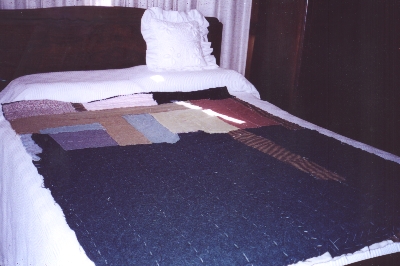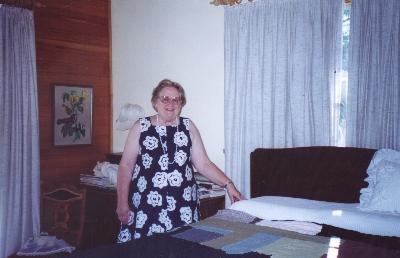Quilt No.833ML - Margaret Lyons

1580 x 1200mm
The quilt, of which this is the padding and backing, was made by Helga Johansen in Tasmania about 1962 or 1963. It is now owned by her daughter Margaret Lyons.
Helga Johansen (1898-1986) was born in Trondheim, Norway and the family came to Australia when she was 2.
Margaret Lyons comments 9.2.2001:
"All my mother's stitching, all her own work. You have to start with a main backing piece, mum used wool, an old thin blanket, I'd say. I believe you can use hessian.
Then they would stitch on to it, I'd say in this case, two layers of fabrics, or could be three, according to the thickness of the thing you're using. She's tacked it in lines about four inches apart. But she's also tacked these pieces, tacked together, where they joined, like a flat stitch. Where they overlap, meet another piece, she's used overcasting. But it's generally tacked in rows four inches apart all in one direction.
[discussing the patches] I would say that consists of an angora mixture skirt or dress, a woollen flannel, that would be a woollen fabric with a nap [light yellow], a soft knitted woollen fabric or similar [speckled wool]. And these are parts of hand knitted garments [pink and black pieces]. Down one end she's got four layers, including the backing.
[about the filling] I'd say any fabric that you think would give warmth. That's a lacy thing, it's got a glittery thing, I think that's part of a stole, don't you. And then she's tacked it all the way around the edge. Here, look, pure wool underwear, that is. Mum used to wear those woollen vests, that was probably a piece of one of her vests. [the blue fabric] I bet that's a bit of synthetic. I don't know what that would have been, very soft, isn't it?.
She told me when you make the cover, you make it like a big pillow case, then you tack it all in place, this way and this way, so it all stays put, and then you machine stitch it. Now, I think she would have started near the edge - four inches in from the edge, and then continue with rows of stitching four inches from that row, each four inches apart. Until you come to the portion in the middle, about 18 inches square or oblong, roughly 18 inches by whatever. You would mark the centre, with pins or anything, mark the centre of the square or rectangle, then you'd draw four petals from those points to make a flower, and then you machine sew over those lines. You could draw them with chalk.
They looked absolutely beautiful on the beds, I remember them, plain as day. She used to make them on the treadle sewing machine. She said it was good as it was easy to manouvre.
Now this material at the time, I'm going back - she would have made these rugs, the ones we had at home when I was little, in the mid 30s - and the fabric she covered them with at the time was called washing satin. One was like a rich red colour, and the other, I would call it royal blue.
She made this one, let me see, I think she made it around 1962 or 1963. I thought she made it for Barbara, for my sister, her baby, born around that time. But she never finished it. She made the stitching very straight."
[Based on interview with Margaret Lyons by Zoe Scott for the National Quilt Register, 12.2.2001]

Related Quilts:
1620 x 1180mm
1850 x 1100mm
2440 x 2150mm






